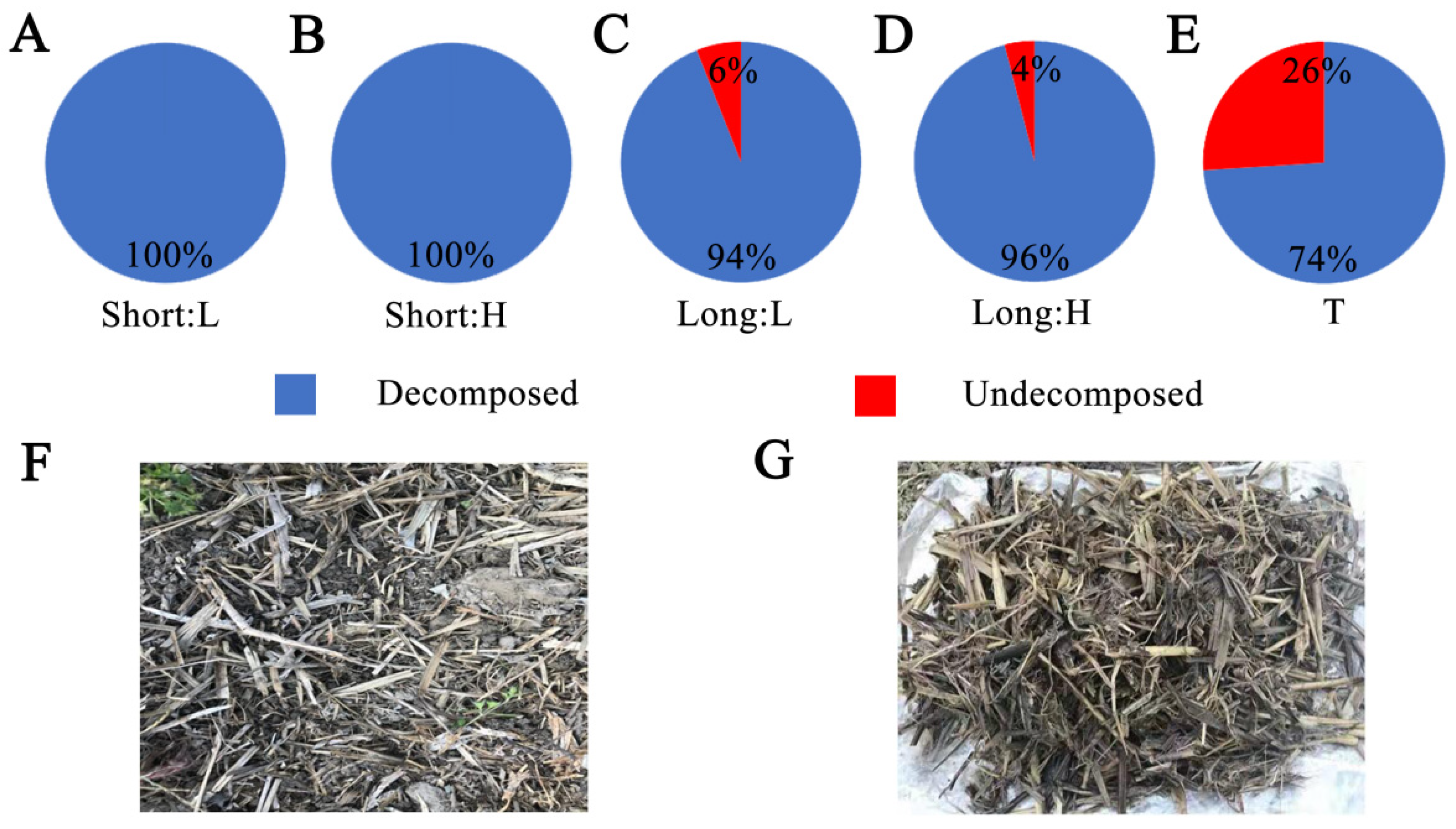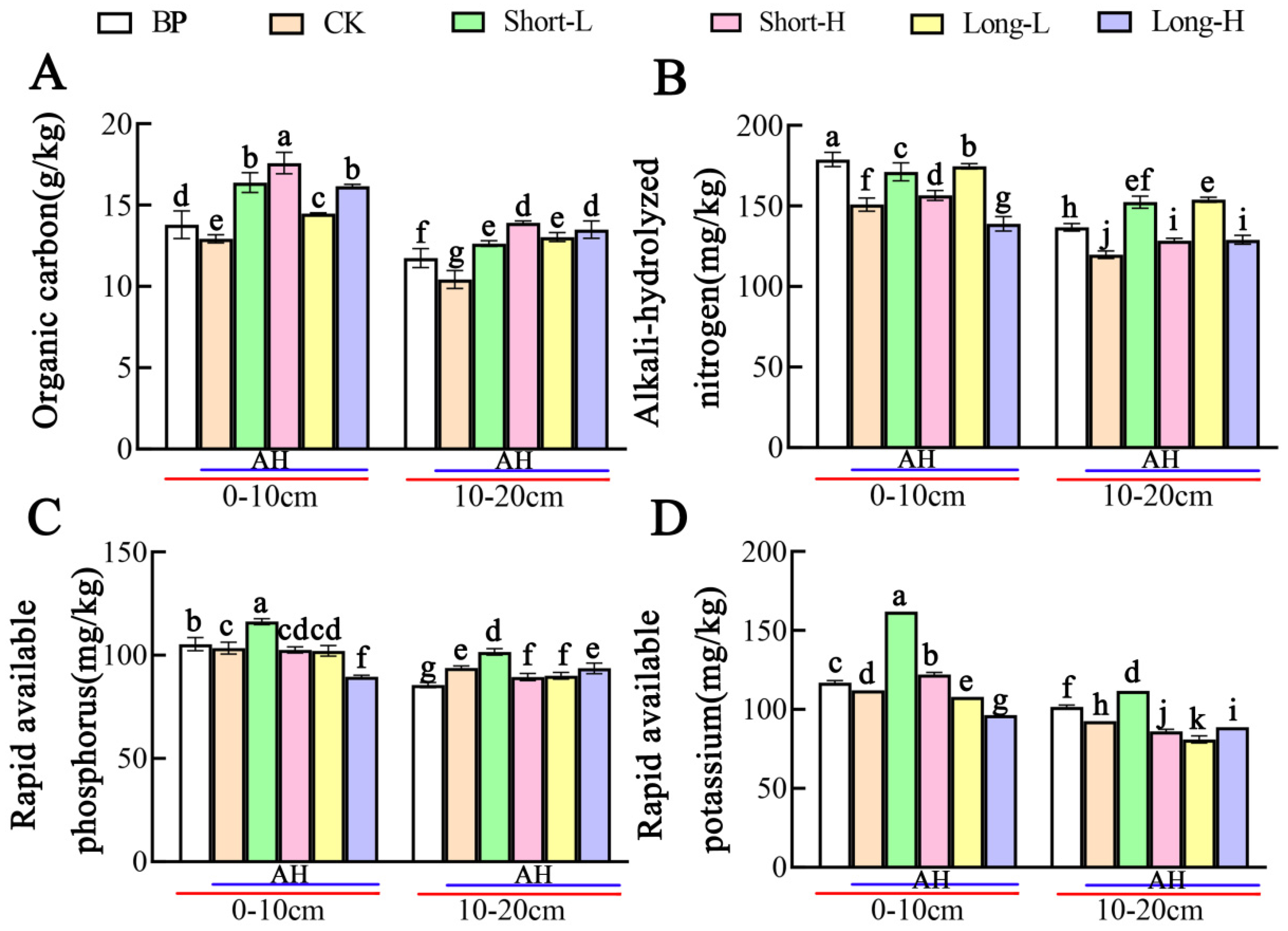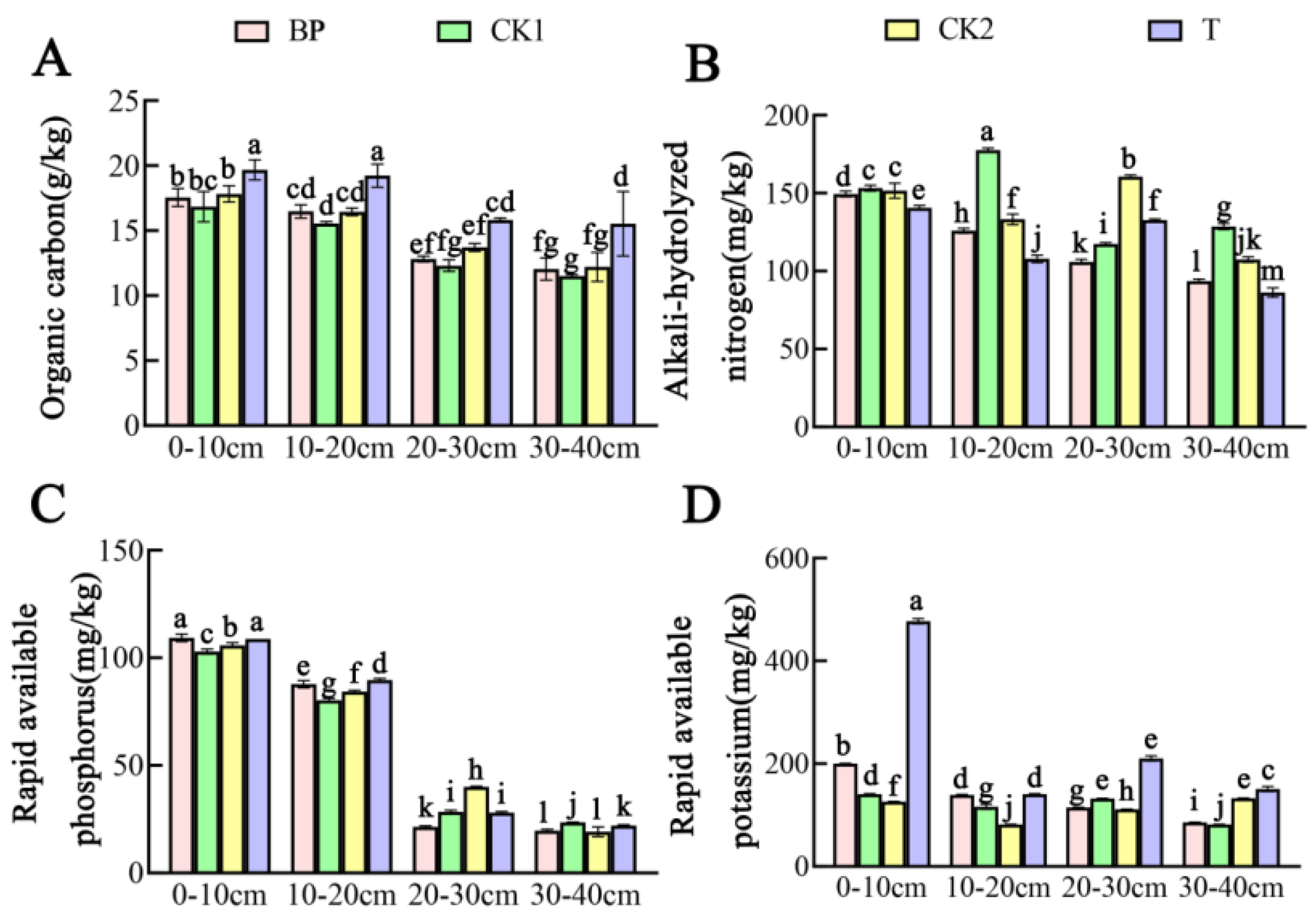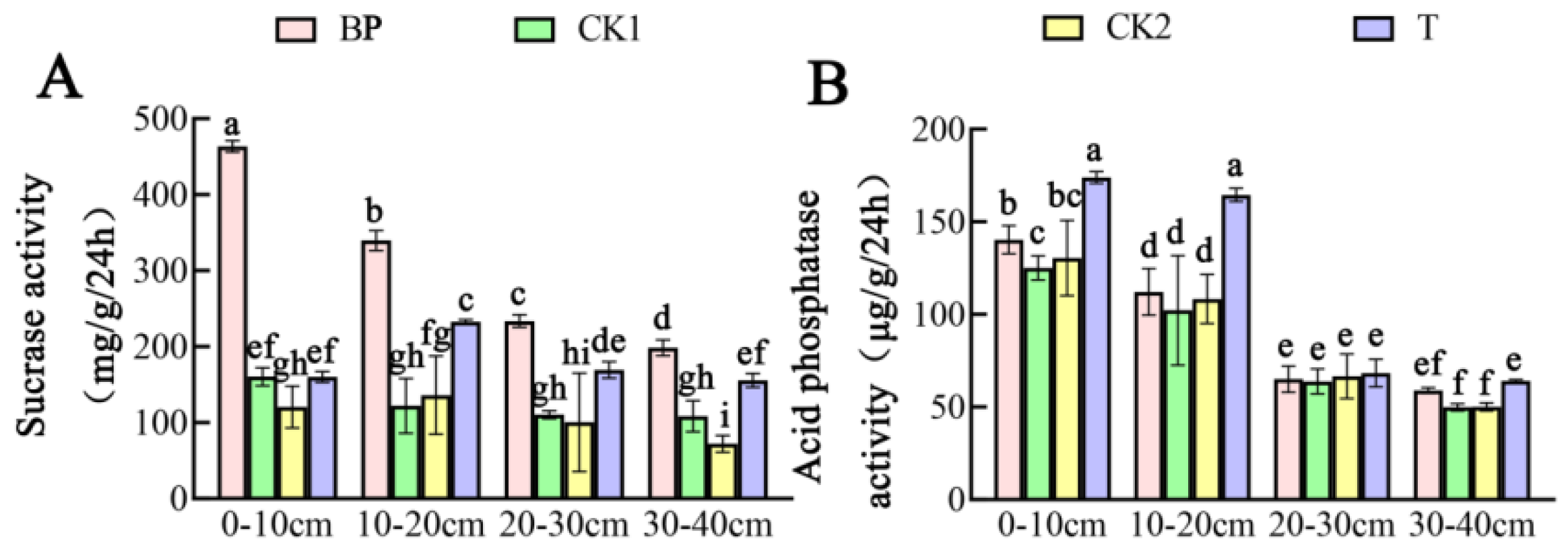Taro (Colocasia esculenta (L.) Schott) Yields and Soil Chemical Properties Were Improved by Row-Surface Straw Mulching
Abstract
1. Introduction
2. Materials and Methods
2.1. Site Description
2.2. Experimental Materials
3. Experimental Design and Treatments
3.1. Wheat Straw Mulching Experiment
3.2. Rice Straw Mulching
3.3. Soil Sampling
3.4. Determination of Soil Chemical Properties
3.5. Determination of Enzymatic Activities
3.6. Statistical Analysis
4. Result
4.1. Decomposition Rate of Crop Straws
4.2. Effects of Different Wheat Straw Mulching Treatments on Taro Yields
4.3. Effects of Wheat Straw Mulching on Soil Nutrients
4.4. Effects of Wheat Straw Mulching on Soil Enzyme Activities
4.5. Effect of Rice Straw Mulching on Taro Yields
4.6. Effects of Rice Straw Mulching on the Soil Nutrients
4.7. Effects of Rice Straw Mulching on the Soil Enzyme Activities
5. Discussion
6. Conclusions
Author Contributions
Funding
Acknowledgments
Conflicts of Interest
References
- Zhou, W.; Ma, T.T.; Chen, L.; Wu, L.H.; Luo, Y.M. Application of catastrophe theory in comprehensive ecological security assessment of plastic greenhouse soil contaminated by phthalate esters. PLoS ONE 2018, 13, e0205680. [Google Scholar] [CrossRef] [PubMed]
- Lupatini, M.; Korthals, G.W.; de Hollander, M.; Janssens, T.K.S.; Kuramae, E.E. Soil microbiome is more heterogeneous in organic than in conventional farming system. Front. Microbiol. 2017, 7, 02064. [Google Scholar] [CrossRef] [PubMed]
- Ju, X.T.; Xing, G.X.; Chen, X.P.; Zhang, S.L.; Zhang, L.J.; Liu, X.J.; Cui, Z.L.; Yin, B.; Christie, P.; Zhu, Z.L.; et al. Reducing environmental risk by improving N management in intensive Chinese agricultural systems. Proc. Natl. Acad. Sci. USA 2009, 106, 3041–3046. [Google Scholar] [CrossRef] [PubMed]
- Yin, H.J.; Zhao, W.Q.; Li, T.; Cheng, X.Y.; Liu, Q. Balancing straw returning and chemical fertilizers in China: Role of straw nutrient resources. Renew. Sustain. Energy Rev. 2018, 81, 2695–2702. [Google Scholar] [CrossRef]
- Hu, W.Y.; Zhang, Y.X.; Huang, B.; Teng, Y. Soil environmental quality in greenhouse vegetable production systems in eastern China: Current status and management strategies. Chemosphere 2017, 170, 183–195. [Google Scholar] [CrossRef]
- Duncan, A.J.; Samaddar, A.; Blummel, M. Rice and wheat straw fodder trading in India: Possible lessons for rice and wheat improvement. Field Crop. Res. 2020, 246, 107680. [Google Scholar] [CrossRef]
- Hou, R.; Hu, J.; Wang, Y.; Wei, H.; Gao, M.T. Simultaneous production of cellulase and ferulic acid esterase by penicillium decumbens with rice straw as the sole carbon source. J. Biosci. Bioeng. 2020, 129, 276–283. [Google Scholar] [CrossRef]
- Paul, A.S.; Panwar, N.L.; Salvi, B.L.; Jain, S.; Sharma, D. Experimental investigation on the production of bio-oil from wheat straw. Energy Sources Part A 2020, 6, 1–16. [Google Scholar] [CrossRef]
- Gosens, J.; Lu, Y.; He, G.Z.; Bluemling, B.; Beckers, T.A. Sustainability effects of household-scale biogas in rural China. Energy Policy 2013, 54, 273–282. [Google Scholar] [CrossRef]
- Sun, D.Q.; Bai, J.F.; Qiu, H.G.; Cai, Y.Q. Impact of government subsidies on household biogas use in rural China. Energy Policy 2014, 73, 748–756. [Google Scholar] [CrossRef]
- Liu, W.; Lund, H.; Mathiesen, V.B.; Zhang, X.L. Potential of renewable energy systems in China. Appl. Energy 2011, 88, 518–525. [Google Scholar] [CrossRef]
- Zhao, X.; Wang, J.W.; Wang, S.Q.; Xing, G.X. Successive straw biochar application as a strategy to sequester carbon and improve fertility: A pot experiment with two rice/wheat rotations in paddy soil. Plant Soil 2014, 378, 279–294. [Google Scholar] [CrossRef]
- Zhang, D.; Yan, M.; Niu, Y.; Liu, X.; Zwieten, L.V.; Chen, D.; Bian, R.I.; Cheng, K.; Li, L.Q.; Joseph, S.; et al. Is current biochar research addressing global soil constraints for sustainable agriculture? Agric. Ecosyst. Environ. 2016, 226, 25–32. [Google Scholar] [CrossRef]
- Sun, D.Q.; Ge, Y.; Zhou, Y.H. Punishing and rewarding: How do policy measures affect crop straw use by farmers? An empirical analysis of Jiangsu Province of China. Energy Policy 2019, 134, 110882. [Google Scholar] [CrossRef]
- Mourtzinis, S.; Gaska, J.; Diallo, T.; Lauer, J.G.; Conley, S. Legacy effects of three management practices on corn, soybean, and wheat yield. Agron. J. 2018, 110, 418–424. [Google Scholar] [CrossRef]
- Zhu, H.; Wang, Z.X.; Luo, X.M.; Song, J.X.; Huang, B. Effects of straw incorporation on Rhizoctonia solani inoculum in paddy soil and rice sheath blight severity. J. Agric. Sci. 2014, 152, 741–748. [Google Scholar] [CrossRef]
- Gondim, A.R.D.O.; Puiatti, M.; Ventrella, M.C.; Cecon, P.R. Plasticidade anatomica da folha de taro cultivado sob diferentes condicoes de sombreamento [Leaf plasticity in taro plants under different shade conditions]. Bragantia 2008, 67, 1037–1045. [Google Scholar] [CrossRef][Green Version]
- Ribeiro Pereira, P.; Bertozzi de Aquino Mattos, E.; Nitzsche Teixeira Fernandes Correa, A.C.; Afonso Vericimo, M.; Margaret Flosi Paschoalin, V. Anticancer and immunomodulatory benefits of taro (Colocasia esculenta) corms, an underexploited tuber crop. Int. J. Mol. Sci. 2021, 22, 265. [Google Scholar] [CrossRef]
- Kaushal, P.; Kumar, V.; Sharma, H.K. Utilization of taro (Colocasia esculenta): A review. J. Food Sci. Technol. 2015, 52, 27–40. [Google Scholar] [CrossRef]
- Nakajima, M.; Cheng, W.G.; Tang, S.R.; Hori, Y.; Yaginuma, E.; Hattori, S.; Hanayama, S.; Tawaraya, K.; Xu, X.K. Modeling aerobic decomposition of rice straw during the off-rice season in an Andisol paddy soil in a cold temperate region of Japan: Effects of soil temperature and moisture. Soil Sci. Plant Nutr. 2016, 62, 90–98. [Google Scholar] [CrossRef]
- Dewis, J.; Freitas, F. Physical and chemical method of soil and water analysis. FAO Soils Bull. 1970, 10, 275. [Google Scholar]
- Chen, B.L.; Yang, H.K.; Song, W.C.; Liu, C.Y.; Xu, J.; Zhao, W.Q.; Zhou, Z.G. Effect of N fertilization rate on soil alkali-hydrolyzable N, subtending leaf N concentration, fiber yield, and quality of cotton. Crop J. 2016, 4, 323–330. [Google Scholar] [CrossRef]
- Roberts, T.; Ross, W.; Norman, R.; Slaton, N.; Wilson, C. Predicting nitrogen fertilizer needs for rice in Arkansas using alkaline-hydrolyzable-nitrogen. Soil Sci. Soc. Am. J. 2011, 75, 1161–1171. [Google Scholar] [CrossRef]
- Li, W.H.; Liu, Q.Z. The dynamic characteristics of soil enzyme activity and nematode diversity in replanted strawberry rhizosphere soil. Acta Hortic. 2017, 1156, 235–242. [Google Scholar] [CrossRef]
- Wen, Y.M.; You, J.W.; Zhu, J.; Hu, H.Q.; Gao, J.S.; Huang, J. Long-term green manure application improves soil K availability in red paddy soil of subtropical China. J. Soils Sediments 2020, 21, 63–72. [Google Scholar] [CrossRef]
- Tabatabai, M.A.; Bremner, J.M. Use of p-nitrophenyl phosphate for assay of soil phosphatase activity. Soil Biol. Biochem. 1969, 1, 301–307. [Google Scholar] [CrossRef]
- Zhao, J.L.; Wang, X.G.; Zhuang, J.; Cong, Y.J.; Lu, Y.; Guo, M.Z. Fine-crush straw returning enhances dry matter accumulation rate of maize seedlings in northeast China. Agronomy 2021, 11, 1144. [Google Scholar] [CrossRef]
- Mizuta, K.; Taguchi, S.; Sato, S. Soil aggregate formation and stability induced by starch and cellulose. Soil Biol. Biochem. 2015, 87, 90–96. [Google Scholar] [CrossRef]
- Yang, H.S.; Feng, J.X.; Zhai, S.L.; Dai, Y.J.; Xu, M.M.; Wu, J.S.; Shen, M.X.; Bian, X.M.; Koidec, R.T.; Liu, j. Long-term ditch-buried straw return alters soil water potential, temperature, and microbial communities in a rice-wheat rotation system. Soil Tillage Res. 2016, 163, 21–31. [Google Scholar] [CrossRef]
- Xiu, L.Q.; Zhang, W.M.; Sun, Y.Y.; Wu, D.; Meng, J.; Chen, W.F. Effects of biochar and straw returning on the key cultivation limitations of Albic soil and soybean growth over 2 years. Catena 2019, 173, 481–493. [Google Scholar] [CrossRef]
- Huang, R.; Lan, M.L.; Liu, J.; Gao, M. Soil aggregate and organic carbon distribution at dry land soil and paddy soil: The role of different straws returning. Environ. Sci. Pollut. Res. 2017, 24, 27942–27952. [Google Scholar] [CrossRef] [PubMed]
- Lu, F. How can straw incorporation management impact on soil carbon storage? A meta-analysis. Mitig. Adapt. Strat. Glob. Chang. 2015, 20, 1545–1568. [Google Scholar] [CrossRef]
- Cui, Y.F.; Meng, J.; Wang, Q.X.; Zhang, W.M.; Cheng, X.Y.; Chen, W.F. Effects of straw and biochar addition on soil nitrogen, carbon, and super rice yield in cold waterlogged paddy soils of North China. J. Integr. Agric. 2017, 16, 1064–1074. [Google Scholar] [CrossRef]
- Zhao, Y.C.; Wang, M.Y.; Hu, S.J.; Zhang, X.D.; Ouyang, Z.; Zhang, G.L.; Huang, B.; Zhao, S.W.; Wu, J.S.; Xie, D.T.; et al. Economics-and policy-driven organic carbon input enhancement dominates soil organic carbon accumulation in Chinese croplands. Proc. Nat. Acad. Sci. USA 2018, 115, 4045–4050. [Google Scholar] [CrossRef] [PubMed]
- Yusefi, A.; Farrokhian Firouzi, A.; Aminzadeh, M. The effects of shallow saline groundwater on evaporation, soil moisture, and temperature distribution in the presence of straw mulch. Hydrol. Res. 2020, 51, 720–738. [Google Scholar] [CrossRef]
- Cao, J.; Liu, C.; Zhang, W.; Guo, Y. Effect of integrating straw into agricultural soils on soil infiltration and evaporation. Water Sci. Technol. 2012, 65, 2213–2218. [Google Scholar] [CrossRef] [PubMed]
- Fan, J.; Gao, Y.; Wang, Q.J.; Sukhdev, S.M.; Li, Y.Y. Mulching effects on water storage in soil and its depletion by alfalfa in the Loess Plateau of northwestern China. Agric. Water Manag. 2014, 138, 10–16. [Google Scholar] [CrossRef]
- Lenka, N.K.; Lal, R. Soil aggregation and greenhouse gas flux after 15 years of wheat straw and fertilizer management in a no-till system. Soil Tillage Res. 2013, 126, 78–89. [Google Scholar] [CrossRef]
- Tian, G.L.; Brussaard, L.; Kang, B.T. An index for assessing the quality of plant residues and evaluating their effects on soil and crop in the (sub-) humid tropics. Appl. Soil Ecol. 1995, 2, 25–32. [Google Scholar] [CrossRef]
- Mando, A.; Brussaard, L. Contribution of termites to the breakdown of straw under Sahelian conditions. Biol. Fertil. Soils 1999, 29, 332–334. [Google Scholar] [CrossRef]
- Krishnan, A.; Convey, P.; Gonzalez, M.; Smykla, J.; Alias, S.A. Effects of temperature on extracellular hydrolase enzymes from soil microfungi. Polar Biol. 2018, 41, 537–551. [Google Scholar] [CrossRef]
- Wang, W.; Lai, D.Y.F.; Wang, C.; Pan, T.; Zeng, C. Effects of rice straw incorporation on active soil organic carbon pools in a subtropical paddy field. Soil Tillage Res. 2015, 152, 8–16. [Google Scholar] [CrossRef]
- Li, J.F.; Zhong, F.F. Nitrogen release and re-adsorption dynamics on crop straw residue during straw decomposition in an Alfisol. J. Integr. Agric. 2021, 20, 248–259. [Google Scholar] [CrossRef]
- Ghimire, R.; Adhikari, K.R.; Chen, Z.S.; Shah, S.C.; Dahal, K.R. Soil organic carbon sequestration as affected by tillage, crop residue, and nitrogen application in rice–wheat rotation system. Paddy Water Environ. 2012, 10, 95–102. [Google Scholar] [CrossRef]
- Johnson, J.M.F.; Novak, J.M.; Varvel, G.E.; Stott, D.E.; Osborne, S.L.; Karlen, D.L.; Lamb, J.A.; Baker, J.; Adler, P.R. Crop residue mass needed to maintain soil organic carbon levels: Can it be determined? BioEnergy Res. 2014, 7, 481–490. [Google Scholar] [CrossRef]
- Liu, S.W.; Wang, M.J.; Yin, M.; Chu, G.; Xu, C.M.; Zhang, X.G.; Abliz, N.; Tang, C.X.; Wang, D.Y.; Chen, S. Fifteen years of crop rotation combined with straw management alters the nitrogen supply capacity of upland-paddy soil. Soil Tillage Res. 2022, 215, 105219. [Google Scholar] [CrossRef]
- Fan, R.Q.; Zhang, B.H.; Li, J.Y.; Zhang, Z.H.; Liang, A.Z. Straw-derived biochar mitigates CO2 emission through changes in soil pore structure in a wheat-rice rotation system. Chemosphere 2020, 243, 125329. [Google Scholar] [CrossRef]
- Burns, R.G.; Deforest, J.L.; Marxsen, J.; Sinsabaugh, R.L.; Stromberger, M.E.; Wallenstein, M.D.; Weintraubg, M.N.; Zoppinih, A. Soil enzymes in a changing environment: Current knowledge and future directions. Soil Biol. Biochem. 2013, 58, 216–234. [Google Scholar] [CrossRef]
- Wei, K.; Chen, Z.H.; Zhu, A.N.; Zhang, J.B.; Chen, L.J. Application of 31P NMR spectroscopy in determining phosphatase activities and P composition in soil aggregates influenced by tillage and residue management practices. Soil Tillage Res. 2014, 138, 35–43. [Google Scholar] [CrossRef]
- Yu, P.J.; Liu, S.W.; Han, K.X.; Guan, S.C.; Zhou, D.W. Conversion of cropland to forage land and grassland increases soil labile carbon and enzyme activities in northeastern China. Agric. Ecosyst. Environ. 2017, 245, 83–91. [Google Scholar] [CrossRef]
- Pajares, S.; Gallardo, J.F.; Masciandaro, G.; Ceccanti, B.; Etchevers, J.D. Enzyme activity as an indicator of soil quality changes in degraded cultivated Acrisols in the Mexican Trans-volcanic Belt. Land Degrad. Dev. 2011, 22, 373–381. [Google Scholar] [CrossRef]
- Zhang, J.; Bo, G.; Zhang, Z.; Kong, F.; Wang, Y.; Shen, G. Effects of straw incorporation on soil nutrients, enzymes, and aggregate stability in tobacco fields of China. Sustainability 2016, 8, 710. [Google Scholar] [CrossRef]
- Ji, B.Y.; Hu, H.; Zhao, Y.L.; Mu, X.Y.; Liu, K.; Li, C.H. Effects of deep tillage and straw returning on soil microorganism and enzyme activities. Sci. World J. 2014, 2014, 451493. [Google Scholar] [CrossRef] [PubMed]
- Zhang, Y.L.; Chen, L.J.; Duan, Z.H.; Wu, Z.J.; Sun, C.X.; Wang, J.Y. Change in soil enzymes activities after adding biochar or straw by fluorescent microplate method. Spectrosc. Spectr. Anal. 2014, 34, 455–459. [Google Scholar] [CrossRef]







| Straw Type | Total Nitrogen mg/g | Total Phosphorus mg/g | Total Potassium mg/g | Organic Carbon g/kg |
|---|---|---|---|---|
| Rice | 7.64 | 3.22 | 26.13 | 386.17 |
| Wheat | 4.43 | 4.52 | 24.73 | 430.78 |
| Total Yield of Taro (kg/ha) | ||
|---|---|---|
| Treatment | Short straw | Long straw |
| CK | 18,231 ± 332 c | |
| L | 19,281 ± 216 b | 18,403 ± 214 c |
| H | 20,642 ± 138 a | 20,243 ± 125 a |
| Straw size | * | |
| Straw amount | * | |
| Size × Amount | NS | |
| Different Treatments | Total Output kg/ha |
|---|---|
| CK1 | 25,518 ± 385 b |
| CK2 | 23,102 ± 425 c |
| T | 27,086 ± 980 a |
Publisher’s Note: MDPI stays neutral with regard to jurisdictional claims in published maps and institutional affiliations. |
© 2022 by the authors. Licensee MDPI, Basel, Switzerland. This article is an open access article distributed under the terms and conditions of the Creative Commons Attribution (CC BY) license (https://creativecommons.org/licenses/by/4.0/).
Share and Cite
Zhu, Z.; Qian, J.; Zhang, Y.; Zhang, H.; Dai, H.; Zhang, Z.; Miao, M.; Jiang, J. Taro (Colocasia esculenta (L.) Schott) Yields and Soil Chemical Properties Were Improved by Row-Surface Straw Mulching. Agronomy 2022, 12, 645. https://doi.org/10.3390/agronomy12030645
Zhu Z, Qian J, Zhang Y, Zhang H, Dai H, Zhang Z, Miao M, Jiang J. Taro (Colocasia esculenta (L.) Schott) Yields and Soil Chemical Properties Were Improved by Row-Surface Straw Mulching. Agronomy. 2022; 12(3):645. https://doi.org/10.3390/agronomy12030645
Chicago/Turabian StyleZhu, Zihui, Jiayu Qian, Yongxian Zhang, Hao Zhang, Haibo Dai, Zhiping Zhang, Minmin Miao, and Jiezeng Jiang. 2022. "Taro (Colocasia esculenta (L.) Schott) Yields and Soil Chemical Properties Were Improved by Row-Surface Straw Mulching" Agronomy 12, no. 3: 645. https://doi.org/10.3390/agronomy12030645
APA StyleZhu, Z., Qian, J., Zhang, Y., Zhang, H., Dai, H., Zhang, Z., Miao, M., & Jiang, J. (2022). Taro (Colocasia esculenta (L.) Schott) Yields and Soil Chemical Properties Were Improved by Row-Surface Straw Mulching. Agronomy, 12(3), 645. https://doi.org/10.3390/agronomy12030645






